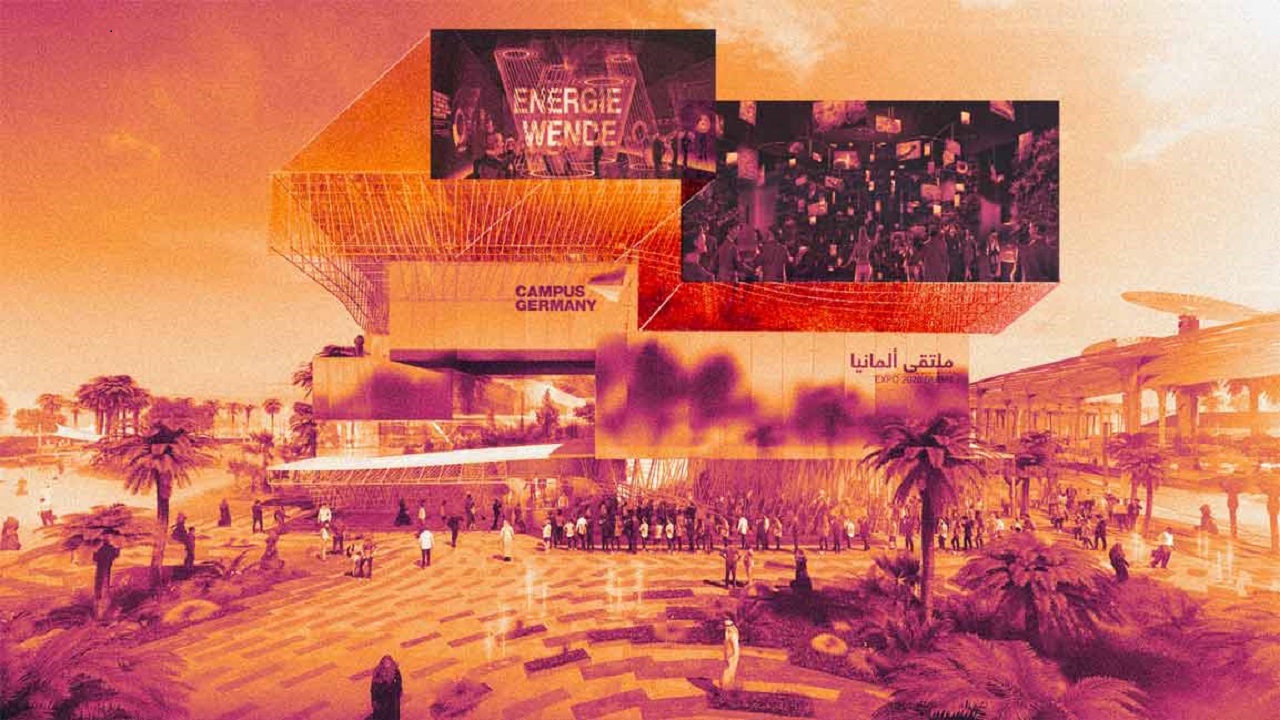- | 2:00 pm
How Campus Germany became the ultimate lesson for sustainability

In perfect orchestration with Benjamin Franklin’s words “involve me, and I remember,” the creators of Campus Germany ensured optimal visitor engagement with a university’s metaphoric usage through their pavilion. Breaking down complex terms in digestible formats, the Germany pavilion, in its university garb, showcased the nation’s latest innovations and technology.
Campus Germany began as a complex project. The attempt was to curate the pavilion in a manner it looked and felt, in equal parts, like a learning institute. Located in the Sustainability District, Campus Germany looked like a college out of UAE’s Academic City. The snake-like queues outside it, though coincidental, seemed supplanted out of a real university.
With dressing the part taken care of, Campus Germany needed a thorough curriculum. A multi-disciplinary curriculum, relatable, digestible, and, most of all, memorable. “I think in between all the beautiful sights and attractions, our biggest win was being one that was remembered,” says Andreas Horbelt, the Chief Creative Director of facts and fiction that was responsible for the pavilion’s concept, exhibition and media design. Meanwhile, NUSSLI Adunic oversaw the building’s construction while LAVA Architekten was responsible for the architectural implementation as part of a joint venture.
Education aside, Campus Germany was established on a larger premise. Instead of focusing solely on sustainability, biodiversity, and energy — all featured in interactive experiments at the pavilion — there was a larger message at play.
View this post on Instagram
Since work on the site started during the Trump administration, the political climate significantly influenced the conceptualization. Horbelt says the creators needed to leave people full of hope as they exited the campus. A major chunk of which lay in demystifying people’s thoughts on sustainability.
When people talk about sustainability, they speak about global challenges, hopelessness, and fear. He explains, “People should understand that the challenges in our surroundings are solvable. In some way, the showcase of the hundreds of innovations at Campus Germany signified we’d get through the problems together”.
The make-believe university took visitors through the stages of university life from induction to graduation while showcasing future innovations. It was important to personalize the experience and ensure humans felt a connection with technology throughout the campus.
The idea of a campus tied well with the overall theme of connectivity, Horbelt explains, “once the campus concept emerged, we asked ourselves what would be the best way for our motto of a connected campus to come alive.”
Innovations for the cities of tomorrow
After an induction video, visitors with personalized badges were guided through three zones based on immersive experiences that explored the future through the sub-themes of energy, cities, and nature. With dark, pulsating “energy cables,” the Energy Lab displayed futuristic supply solutions; the Future City Lab’s urban landscape showcased innovations for the cities of tomorrow, and the Biodiversity Lab highlighted the power of natural ecosystems. These learning zones were based on suggestions from scientists, academicians, and politicians. However, planning the easy-to-understand pavilion took nearly four years to complete.
Visiting Campus Germany: The German Pavilion @expo2020dubai is truly a one of a kind experience, blending together education with entertainment; showcasing cutting edge German technology and innovations in the field of climate action @expo2020germany 🇩🇪✨ pic.twitter.com/ZG7SpXFZf4
— شما المزروعي | Shamma Al Mazrui (@shamma) March 25, 2022
“For the pitch, we produced 500 pieces of paper. The concept came to life in a mixture of high-end renders and hand-drawn sketches based on renders. We didn’t use renders for the interiors, but we made a more artistic version of the renders. Visualization was executed in 3D based on Rhino, but we also used Enscape so that we could walk through spaces and see how it felt.”
Due to travel restrictions, the construction complexity was the inability to visit the massive site in person. Additionally, team Campus Germany faced another unforeseen challenge when Ever Given, one of the largest container ships ever built, got stuck in the Suez Canal for six days in March 2021. “All of our equipment was in the ship behind it.”
Despite the crunch in timelines, the pavilion was installed with approximately 50 innovations. Additionally, the campus featured a hybrid cooling model — a smart cooling system for future cities. But Horbelt adds that like the smart cooling model, the solutions showcased at pavilions focused only on one problem. “A lot of sustainable solutions at Expo, including our pavilion, just solve one part. For example, the Monaco Pavilion is fully covered with solar panels to create more energy. The German pavilion has a super-developed climatic concept that does not source any energy. Belgium Pavilion’s Green Arch is innovative urban construction. From the perspective of architecture, Netherlands Pavilion is the most visionary building on the Expo site. It’s the Eiffel Tour of Dubai.”
Following Expo 2020 Dubai’s close, Horbelt has a tight schedule starting with wrapping up the pavilion, “you build something and get good reactions, it’s completely different to close and dismantle it, but it’s part of the process. If people left Campus Germany feeling optimistic and full of hope, the journey seems worth it. I hope to close Campus Germany with the same optimism it was built for.”








































